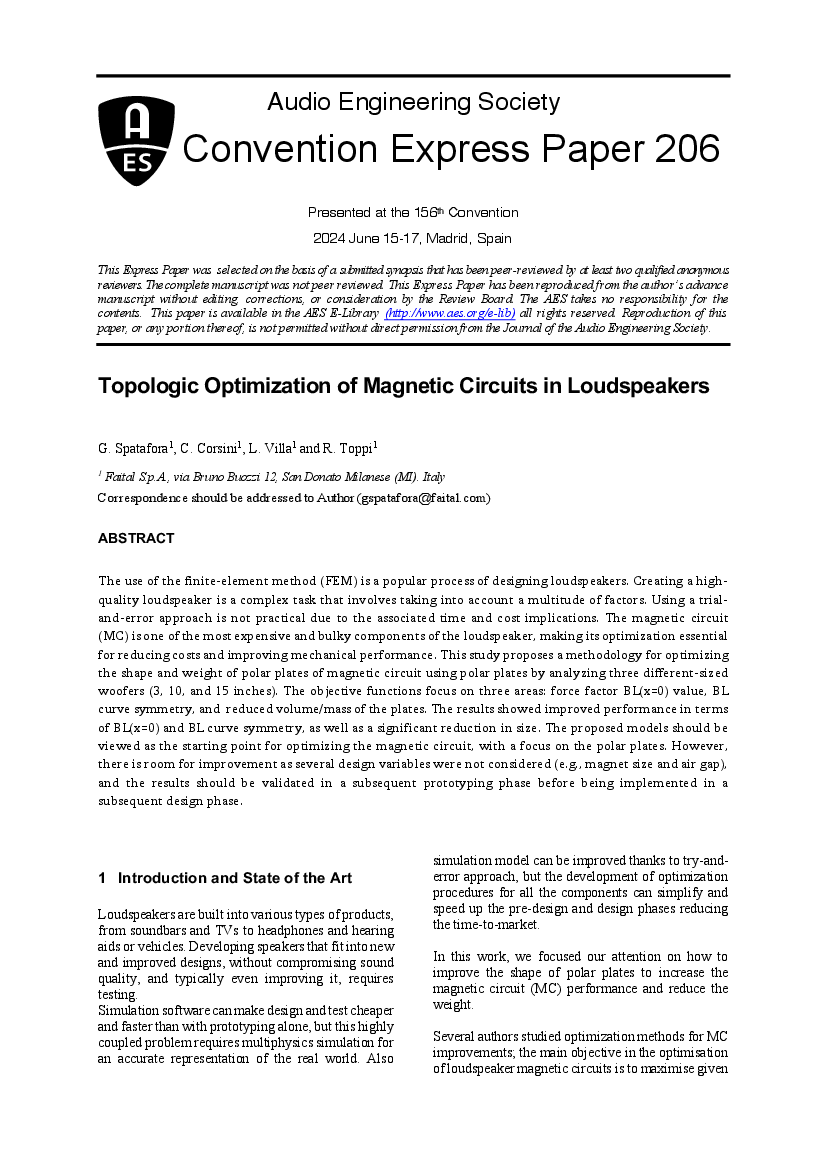Home / Publications / E-library page
You are currently logged in as an
Institutional Subscriber.
If you would like to logout,
please click on the button below.
Home / Publications / E-library page
Only AES members and Institutional Journal Subscribers can download
The use of the finite-element method (FEM) is a popular process of designing loudspeakers. Creating a high-quality loudspeaker is a complex task that involves taking into account a multitude of factors. Using a trial-and-error approach is not practical due to the associated time and cost implications. The magnetic circuit (MC) is one of the most expensive and bulky components of the loudspeaker, making its optimization essential for reducing costs and improving mechanical performance. This study proposes a methodology for optimizing the shape and weight of polar plates of magnetic circuit using polar plates by analyzing three different-sized woofers (3, 10, and 15 inches). The objective functions focus on three areas: force factor BL(x=0) value, BL curve symmetry, and reduced volume/mass of the plates. The results showed improved performance in terms of BL(x=0) and BL curve symmetry, as well as a significant reduction in size. The proposed models should be viewed as the starting point for optimizing the magnetic circuit, with a focus on the polar plates. However, there is room for improvement as several design variables were not considered (e.g., magnet size and air gap), and the results should be validated in a subsequent prototyping phase before being implemented in a subsequent design phase.
Author (s): Spatafora, Grazia; Villa, Luca; Corsini, Chiara; Toppi, Romolo
Affiliation:
Faital S.p.A., via Bruno Buozzi 12, San Donato Milanese (MI). Italy; Faital S.p.A., via Bruno Buozzi 12, San Donato Milanese (MI). Italy; Faital S.p.A., via Bruno Buozzi 12, San Donato Milanese (MI). Italy; Faital S.p.A., via Bruno Buozzi 12, San Donato Milanese (MI). Italy
(See document for exact affiliation information.)
AES Convention: 156
Paper Number:206
Publication Date:
2024-06-06
Import into BibTeX
Permalink: https://aes2.org/publications/elibrary-page/?id=22552
(1750KB)
Click to purchase paper as a non-member or login as an AES member. If your company or school subscribes to the E-Library then switch to the institutional version. If you are not an AES member Join the AES. If you need to check your member status, login to the Member Portal.

Spatafora, Grazia; Villa, Luca; Corsini, Chiara; Toppi, Romolo; 2024; Topologic Optimization of Magnetic Circuits in Loudspeakers [PDF]; Faital S.p.A., via Bruno Buozzi 12, San Donato Milanese (MI). Italy; Faital S.p.A., via Bruno Buozzi 12, San Donato Milanese (MI). Italy; Faital S.p.A., via Bruno Buozzi 12, San Donato Milanese (MI). Italy; Faital S.p.A., via Bruno Buozzi 12, San Donato Milanese (MI). Italy; Paper 206; Available from: https://aes2.org/publications/elibrary-page/?id=22552
Spatafora, Grazia; Villa, Luca; Corsini, Chiara; Toppi, Romolo; Topologic Optimization of Magnetic Circuits in Loudspeakers [PDF]; Faital S.p.A., via Bruno Buozzi 12, San Donato Milanese (MI). Italy; Faital S.p.A., via Bruno Buozzi 12, San Donato Milanese (MI). Italy; Faital S.p.A., via Bruno Buozzi 12, San Donato Milanese (MI). Italy; Faital S.p.A., via Bruno Buozzi 12, San Donato Milanese (MI). Italy; Paper 206; 2024 Available: https://aes2.org/publications/elibrary-page/?id=22552